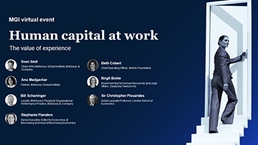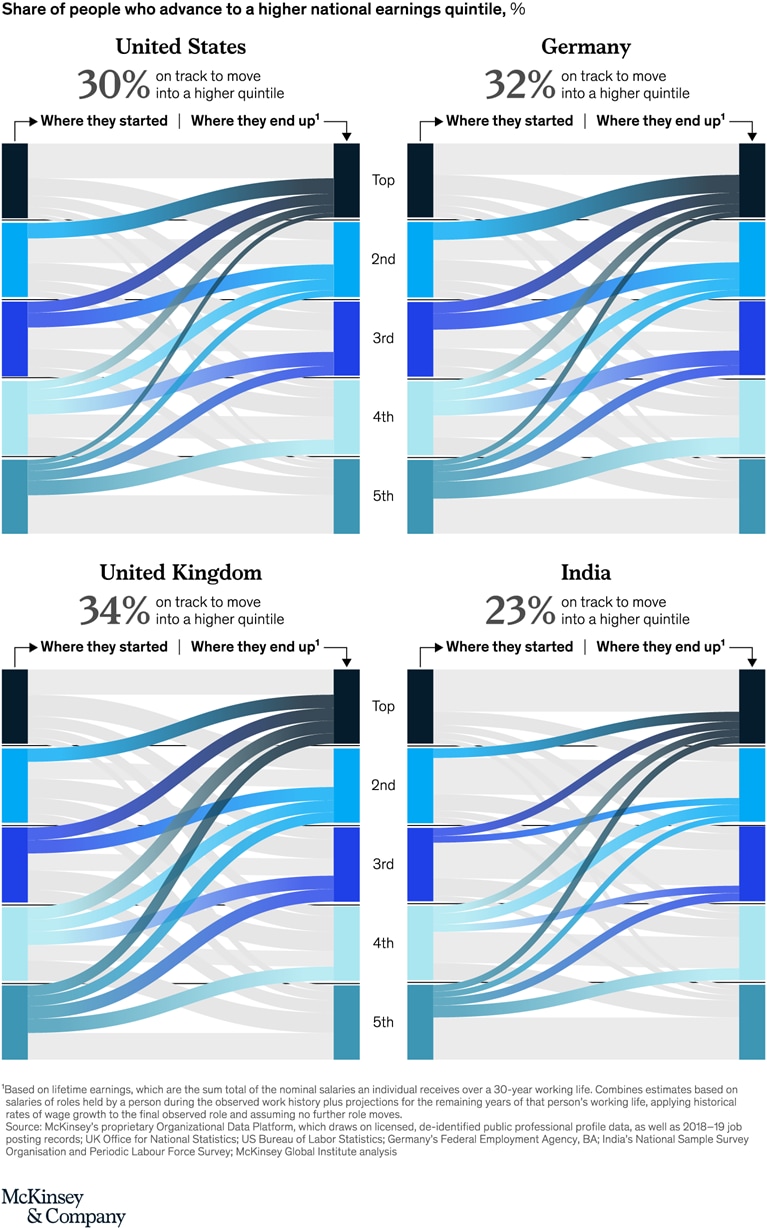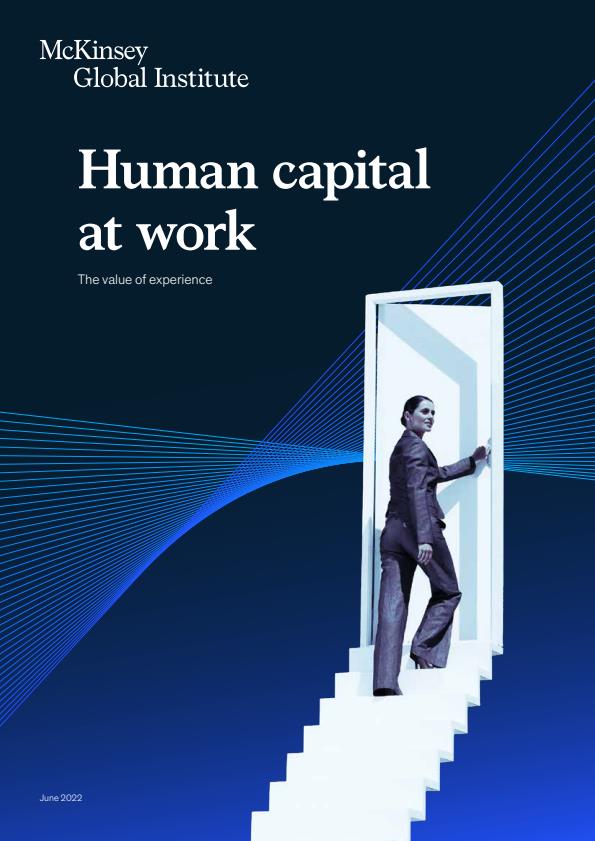The most important resource in any economy or organization is its human capital—that is, the collective knowledge, attributes, skills, experience, and health of the workforce. While human capital development starts in early childhood and continues through formal education, the McKinsey Global Institute and McKinsey’s People & Organizational Performance Practice have focused new research on the next stage, which spans the full working life.
Human capital is much more than a macroeconomic abstraction. Each person has a unique, living, breathing set of capabilities. Those capabilities belong to the individual, who decides where to put them to work. The degree of choice is not limitless, of course. People are the products of geography, family, and education; their starting points matter. Having career options also depends on an individual’s abilities and attributes, their networks, their family obligations, the health of the broader labor market, and societal factors.
While we recognize these constraints, career moves are nevertheless an important mechanism for expanding skills and increasing earnings. The patterns within our data set show that moving into a new role pays off—and even more so when someone lands a new position that stretches their capabilities or represents a match that better utilizes their skills.
In our data sample, roughly a third of US, German, and UK workers, and almost a quarter of Indian workers, are on a path to move up one or more quintiles in estimated lifetime earnings from their career starting points. This upwardly mobile group stands out for making more frequent and bolder role moves. For people without educational credentials who start out in low-paying positions in particular, movement is critical to boosting their earnings.
Role moves help individuals continuously upgrade their skills, raise their income, and build track records that translate into value. However, individuals can’t make bold moves that represent a real leap unless an employer sees their potential and takes a chance on hiring them. The most effective way for an individual to maximize the “experience effect” is to join an organization that prioritizes and strengthens their development.

Watch the replay: Leading voices discuss implications of human capital at work research
Stephanie Flanders of Bloomberg moderates a conversation with Birgit Bohle, Beth Cobert, and Sir Christopher Pissarides on navigating the challenges and opportunities ahead.
Work experience adds to the value of human capital
Our research focuses on how work experience builds on the foundation of formal education and enhances the value of human capital (see Sidebar, “How we model the link between role moves and the addition of skills to lifetime earnings”). We define work experience holistically as the accumulated knowledge that workers gain by being in the labor market. This can occur through doing the work itself, formal employer-provided learning and development programs, and job changes that better match someone’s existing skills or enable that person to add new skills.
Organizations set up their working environments with systems and practices that help employees become more productive. When people enter these settings, value is created. In addition to earning wages, workers gain knowledge and new capabilities that they carry with them for the remainder of their careers. Many roles require employees to become proficient with new types of software or equipment. Employees benefit from structured learning programs and daily coaching on the job. There are insights to be gained from watching colleagues handle tricky situations gracefully (or not) and seeing how managers motivate their teams (or do not).
Someone who starts out taking orders in a fast-food restaurant learns the art of handling difficult customers and staying cool under pressure. Someone who starts in IT by answering questions on a help desk absorbs technical knowledge that they continue to use when they become a network administrator. An inventory clerk who watches his manager solve logistical logjams can apply those approaches in a future role as a warehouse manager or procurement agent.
Work experience contributes 40 to 60 percent of a worker’s human capital
By our estimates, the value of human capital represents roughly two-thirds of an individual’s total wealth. Skills acquired or deployed through work experience contribute an average of 46 percent of this value over a typical working life. However, this is an average for the four focus countries, and it contains a wide range of variations (Exhibit 1).
The experience effect looks strikingly similar across the advanced economies we studied. Our analysis finds that work experience contributes 40 percent of the average individual’s lifetime earnings in the United States, and 43 percent in both Germany and the United Kingdom.
By contrast, work experience contributes 58 percent of average lifetime earnings in India. Access to education remains a key challenge in India—and with only 12 percent of the population having tertiary education as of 2020, work experience will be a more important driver of income for the workforce as a whole by default. In other emerging economies that have similarly low levels of educational attainment plus high productivity and wage growth from a low baseline, lifetime earnings are likely to exhibit similar patterns.
Work experience is a bigger determinant for people who start in occupations without significant credentialing barriers
People who start out in occupations with higher educational and credentialing barriers (such as lawyers and dentists) earn more than other workers over their lifetimes. For most of them, entry-level skills contribute a larger share of those earnings than acquired skills.
The reverse is generally true for people who start out in occupations with lower educational requirements. They typically earn less over a lifetime, with the greater share driven by work experience. The income growth of a dishwasher who becomes a food prep cook, then a line cook, and eventually a sous chef is almost entirely fueled by techniques and tricks of the trade learned on the job. In addition to enabling someone to acquire skills, work experience gives that person a track record, which is valuable in and of itself for the signal it sends to potential future employers.
In the United States, for example, the size of the experience effect varies substantially across starting occupations. At the low end are chiropractors. Before treating patients, they must complete a doctor of chiropractic degree program that can take three to five years, then pass a series of licensing exams. Their entry-level skills account for 85 percent of their lifetime earnings. At the other end of the spectrum are food batchmakers, who operate equipment that blends ingredients for manufacture. People who start in this type of factory job are less likely to have higher education; the experience they amass over time determines 90 percent of their lifetime earnings.
While greater educational attainment generally correlates to higher lifetime earnings, some people defy the odds
Someone who attended poor-quality schools and lacks any postsecondary education or training is starting from behind in the labor market. Many employers rely on college degrees as a well-established signal of a candidate’s employability.
Yet educational disadvantage does not have to lock in destiny—at least not for everyone. In the United States, for example, our lifetime earnings projections show a subset of people who overcome the odds. Of particular note, 28 percent of high school graduates have higher earnings potential than the median holders of associate degrees, and 37 percent of associate degree holders could earn more than median bachelor’s degree holders over their lifetimes.
In all the countries we studied, a sizable cohort is on a path to move up one or more earning quintiles from their career starting point. This applies to roughly one-third of workers in advanced economies (30 percent in the United States, 32 percent in Germany, and 34 percent in the United Kingdom) and to 23 percent of workers in India. In the United States, some 6.1 percent are on track to move from the bottom to the top quintile in earnings.
The upwardly mobile group appears to be amassing work experience in an effective way that yields real benefits. In our worker sample, experience accounts for 60 to 80 percent of lifetime earnings for the cohort that moved up but only 35 to 55 percent for those who stayed flat or dropped down. However, many people are unable to make these leaps because of structural and social barriers, such as biases, the lasting effects of unequal education, and the lack of professional networks.
Role moves bring new skills and can unlock higher earnings—and in most cases, people are moving to new organizations
Movement is an inherent feature of labor markets. Across the entire data set, the average person switched roles every two to four years, with a median skill distance of 25 to 45 percent, depending on the country. This matters because role moves enable individuals to build or demonstrate their skills.
Moves can involve workers assuming new roles within their current company, moving to a different employer, changing specialties or occupations, or pursuing a combination of these strategies. At any given time, a significant proportion of role moves are triggered by firings and layoffs in addition to voluntary job changes.
In our data set, each move increased wages by 6 to 10 percent on average. However, this includes people who moved into lower-paying roles, whether by choice or out of necessity.
Forty to 50 percent of the role moves observed in the decade involved pay increases. The workers who made these moves managed to boost their earnings by 30 to 45 percent on average each time.
More than 80 percent of the role moves observed in our data set involved someone moving from one employer to another. Far fewer moves involved people being promoted into more senior roles or branching into different specializations within their existing organizations. This high level of external movement holds true across all cohorts. This seems to indicate that many employers do not have internal advancement tracks that are wide enough to keep most people growing and working toward higher rewards over time. Individuals who want to reinvent themselves and take on more senior roles often have to go to a new environment to do so.
The bolder the move, the bigger the boost
Those who take new roles involving bigger changes or challenges receive bigger rewards. We look at each individual’s career trajectory, paying particular attention to their role moves. When someone changes jobs, their new position typically has some distinctly new skill requirements that were not present in their previous position, based on our review of job postings. The nonoverlapping share is the “skill distance” between the two roles—and the higher the share, the “bolder” we consider a role move to be.
The illustrative example in Exhibit 2, below, shows a German worker who started as a welder, then changed jobs twice. When he became a maintenance supervisor, the move involved a skill distance of 33 percent; when he later became a production manager, the move involved a skill distance of 47 percent. His average skill distance is therefore 40 percent, which is representative of the typical German worker.

In our data set, salary-increasing moves involved a median skill distance of 35 to 50 percent across countries, higher than the range of 25 to 45 percent for all moves across countries. In other words, when someone made a move for higher pay, their new job typically involved a more significant share of skills and responsibilities that were not part of their previous job.
This kind of movement requires an employer to take a chance on someone’s potential, even if they have not been performing exactly the same tasks in their previous role. The new role may be a major learning opportunity, or it may be a better match that enables someone to deploy existing skills that they have not been utilizing. Incremental moves with largely overlapping requirements do not pack the same punch.
The most upwardly mobile cohorts in the sample make both frequent moves and bold moves (Exhibit 3).1 In the United States, for example, people who moved into higher earning quintiles averaged 4.6 moves during the observed period, while those who stayed flat averaged 3.7 moves. The upwardly mobile in the US and India made moves with an average skill distance of 30 to 40 percent; those who stayed flat averaged only 20 to 30 percent. This growth in skills compounds with each move, resulting in a far bigger shift in capabilities and responsibilities over the entirety of a working life.

‘Experience seekers’ and ‘early movers’ boost their earnings through effective career moves
From our data set, we looked at a smaller universe of people with more than ten years of work history. Within it, four distinct archetypes emerge. They are not meant to convey individuals’ circumstances or motivation; they describe movement patterns and outcomes, with illustrative examples.
- Experience seekers start with lower-than-average wages but propel themselves upward by moving roles more frequently than their peers and stretching their capabilities substantially each time. The cumulative effect gives them stronger wage growth than any other archetype. Consider someone who starts as an administrative assistant at one nonprofit before landing a job cultivating donors in the development department of another. From there, she joins a research hospital as a grant writer before stepping into a broader communications role. Eventually she becomes head of media relations for a major university. Our experience seeker has managed to cross over into new industries and functions.
- Early movers make bigger leaps in the first part of their career. Someone may start in one field, quickly realize that their passion lies elsewhere, and then get a break that enables them to follow it. A graphic designer who makes print ads, for example, might become a user-experience designer early in her career.
- Late movers stay put or make more incremental moves in the early stage of their career but eventually take a bolder step. Think of a seasoned journalist who goes into corporate communications, or a real estate agent who becomes a mortgage loan officer in a bank. This is by far the largest group in the sample.
- Lock-ins change jobs less frequently, and when they do move, they do not make dramatic changes. This is not necessarily because someone is timid or stuck; they could also follow this strategy because they pursued what suited them from the start. Teachers, for example, have invested in specialized education and may have found their calling. Furthermore, our data does not indicate if someone tried to make bolder moves but was unsuccessful. However, lock-ins have the slowest wage growth, whether they start near the bottom or near the top. Doctors start at a very high salary but do not tend to make many role moves. While work experience accounts for 60 to 70 percent of lifetime earnings for experience seekers and early movers, that share is only about 30 percent for lock-ins.
Employers can attract and retain talent by recognizing potential, embracing mobility, and strengthening learning
Not all companies are equally good at developing people. Size is not the differentiator, as we find that small companies can be just as adept as their larger counterparts in this area. But companies with the strongest organizational health, those that offer more structured training for their employees, and those that provide more opportunities for internal advancement seem to stand out. People join these companies to build knowledge and networks, understanding that their experience will provide a valuable signal to other employers for the remainder of their careers. Early career experience at these companies helps employees go on to become more upwardly mobile.
Companies can help individuals grow—and establish themselves as great learning organizations and magnets for talent in the process. Three priorities stand out:
- Understand the potential in people as well as their current knowledge and skills. Most employers can benefit from challenging the status quo of how they select people for open roles. Instead of searching for “holy grail” external candidates whose prior experience precisely matches the responsibilities in an open role, leading organizations create systems for evaluating candidates based on their capacity to learn, their intrinsic capabilities, and their transferable skills. This requires designing assessments that are fit for purpose, focusing on the few core skills that matter for success in the role. It also involves removing biases that pigeonhole people into the roles they are already performing; this point is particularly important when it comes to existing employees. In our sample, more than half of all role moves undertaken by individuals involved a skill distance of more than 25 percent—and this implies that people often have latent capabilities that are not recognized by their current employers. If someone’s track record shows the acquisition of new skills over time, it probably means that person is capable of learning more. Employers should be less constrained about recruiting candidates from traditional sources and backgrounds and more open to people who have taken unconventional career paths.
- Embrace mobility. Within our data set, more than 80 percent of all the role moves individuals made involved changing employers. Since there is no fighting the fact that talented people will move, the key for employers is becoming part of this flow. Employers can aim to beat the odds on both sides of this 80-20 dynamic. On one end, they can attract the best candidates among the big talent pool that is always searching. On the other, they can boost the productivity and engagement of valued employees who stay. To ensure that proven employees don’t have to go elsewhere to advance, organizations should set the expectation that part of a manager’s job is developing people who will go on to other things. Each role should have clear paths toward future roles, with skill requirements delineated at each stage. One way to do this in a large organization is to create an internal digital platform where employees can access learning modules and find their next opportunity. Mobility is experience, not just upward progression. Lateral movement is a neglected opportunity for many organizations. When talented employees do move on, celebrate them as success stories—and don’t close the door on welcoming them back in a different capacity in the future.
- Strengthen coaching, particularly early in an employee’s tenure. A great deal of skills development happens day to day on the job. Coaching and apprenticeship can maximize this effect. Our research suggests that the first few years of a career are foundational, and the same is true for the first year in any new job. Formal onboarding is not just an orientation session but a six-month to one-year period that should involve a thoughtfully created journey. Organizations can provide the tools for a running start, including a manager committed to delivering coaching and facilitating connections. Even after hitting their stride, employees need ongoing opportunities to learn; this can pay off in the form of higher morale and reduced attrition. In a June 2021 Gallup survey, 65 percent of US workers said that learning new skills is an extremely or very important factor in deciding whether to take a new job, and 61 percent said it was extremely or very important in deciding whether to stay at their current job. Formal learning and development programs that prepare employees for future roles are part of this, but it is difficult to make them effective. Companies that are true learning organizations build their own formulas, customized to their needs.


